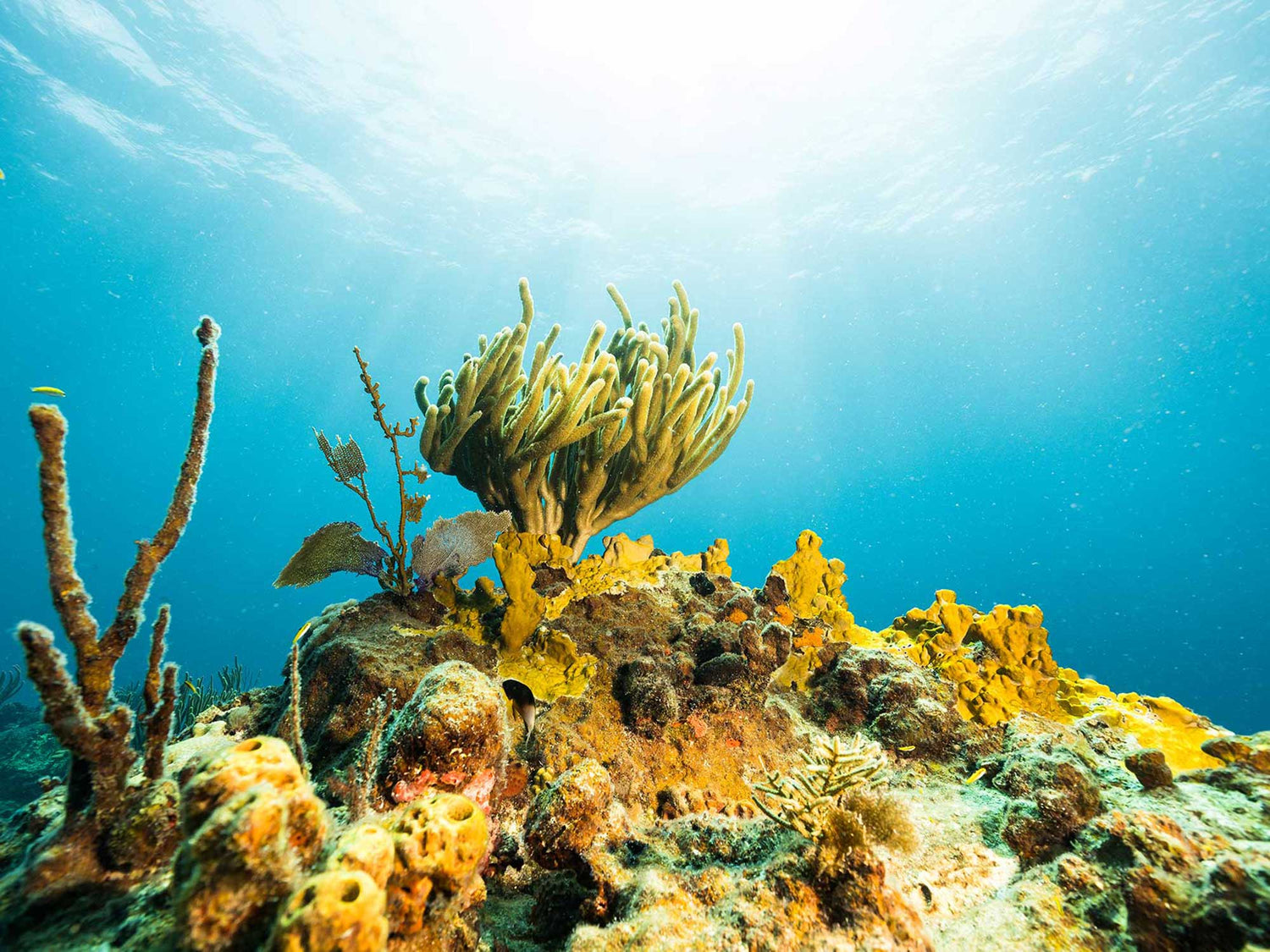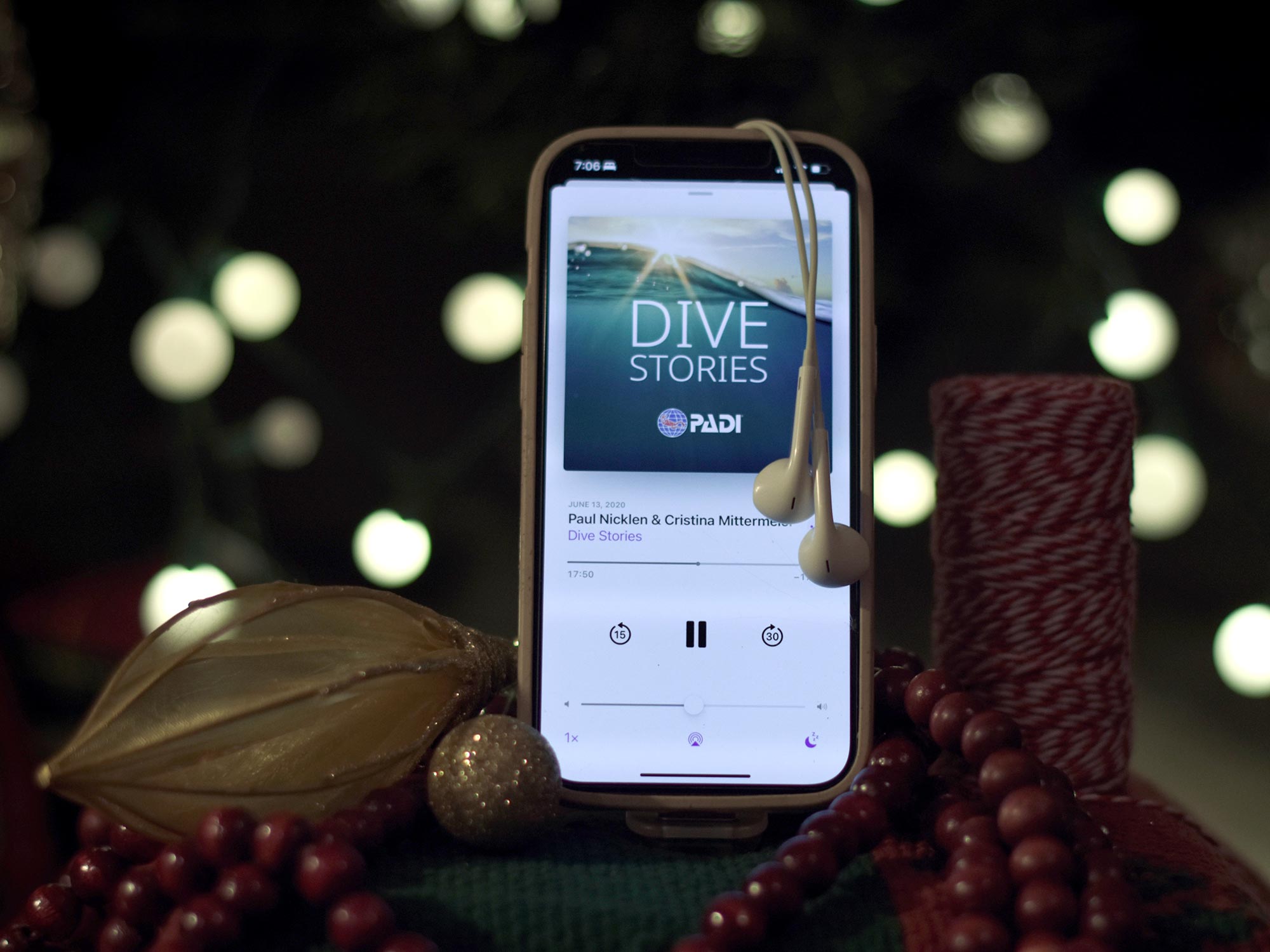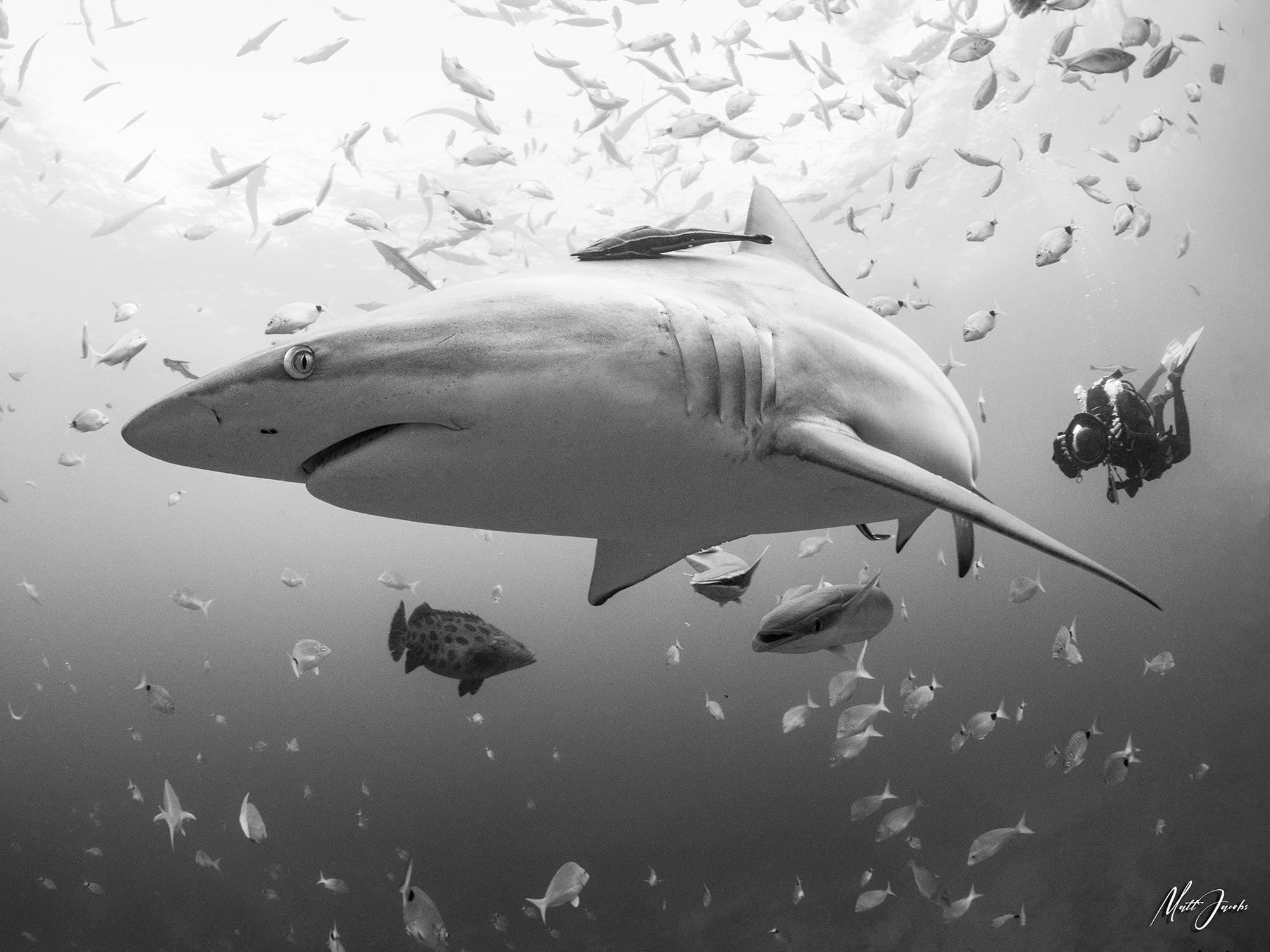Images and story by Dr. Austin Greene
Why do you carry a camera? Whether the one in our smartphones, a point and shoot in a hiking backpack, or a mirrorless in an underwater housing, I believe that most of us carry a camera because we hope that the images we capture will help us tell a story. Whether enthusiast or career professional, a photographer's ability to communicate with their audience through imagery depends on three things: experience, opportunity, and equipment. The first two come only with time and a little bit of luck, respectively. What equipment to bring is where photographers have the most control over the images they bring back, and as I learned on a recent trip, this can make all the difference to the story you tell.
I am a scientist with the great fortune of being able to study what I believe are some of the most beautiful ecosystems on Earth: coral reefs. In September of 2022 I had just finished a cross-country trip from my home in Hawaii to a new position in Massachusetts as a postdoctoral investigator at the Woods Hole Oceanographic Institution (WHOI)—a mecca of marine science for anyone in the field. Just a month after starting, I was packing my dive bag and crates of science materials for a research trip to the United States Virgin Islands. For the first time in my career, I would be joining a group of 21 scientists in an effort to revolutionize how coral reefs are studied, and I wanted to be sure that I had the right equipment to capture our story. I packed my Canon EOS R, a single Canon 14-35 f/4L USM lens, and my Ikelite housing into a soft-sided cooler. For the first time, I also packed a new tool: two Ikelite DS230 strobes and their accoutrements.

A strobe can make all the difference when your subject is one as colorful as a coral colony.

Add a little bit of light to these scenes and you will be rewarded with contrast and color that isn’t available when shooting with natural light only.
Studying the Art of Survival
Most divers are painfully aware that coral reefs are experiencing global decline. Look back at your dive trip photos from a decade ago and the differences are clear: coral reefs overgrown by algae after a losing battle against a changing climate, land-based pollution, and overfishing. Dedicated scientists have spent decades working to solve this puzzle and have made remarkable progress with limited tools and resources, usually just a camera, a measuring stick, and a few temperature sensors. Recent progress made in coral conservation and restoration reflects just how much these scientists care about coral reefs, and the tools we use as reef scientists are rapidly advancing. As we boarded our flight to St. Thomas and a ferry to St. John, our team (WHOI Reef Solutions) looked to accomplish a unique scientific goal: combine multiple state-of-the-art technologies on the reef and discover what enables some corals to survive in a changing ocean.

Dead and dying colonies of even the most charismatic coral species, such as this boulder star coral (Orbicella annularis), are an all-too-familiar scene for divers as coral reefs undergo an unprecedented period of decline.
In parallel with my science, I wanted to capture the complexity of this collaborative research effort. After weeks of planning, I found myself the most air-conditioned room in our rental and began the marriage of camera, housing, and strobes. Before I knew it, I was rolling off the side of a boat, being handed my rig by the skipper, and descending through water thick with nekton and plankton towards the reef. This was new science and I had new tools of my own to help me capture it.

Learning to balance foreground and background lighting with underwater strobes will feel familiar for anyone with experience using flash in their land-based photography. Battling backscatter is an entirely new challenge, at least it was for me. With their bright white and vibrant purple skeletal structures, Sea Fans make for an excellent subject to test your exposure against.
The Data of Water Flow
If you want to understand coral reef health, the first step is to understand the physical environment of the reef. At the start of our mission, the team gently lowered two new instruments, developed by Dr. Matthew H. Long's MACHINE LAB at WHOI, onto the reef. The first of these would process water in real time to understand the metabolism of a living reef, and the second, a maze of tubing and cables, would directly measure how corals alter water flow and chemistry at and above the reef surface. To complete this picture of the reef environment, tilt-meters, sensors that record the direction and speed of ocean flow, were deployed by Dr. Weifang (Gordon) Zhang, providing valuable data that can later be used to validate computer simulations of ocean flow over these instrumented reefs. In water murkier than expected I set my strobes and adjusted my focal length as wide as possible to put these instruments in context of the reef’s unique topography. For such a challenging environment I was surprised by the exposure accuracy of the TTL system and appreciated the extra color and contrast provided by the strobes.

An instrument used to assess water chemistry in real time above the reef is kept in position with the use of a few small floats.

A gradient water sampling system on the reef used to measure the ways corals modify water flow over the reef. A strobe used in the this image provides contrast and detail that is otherwise missing from the previous image.
The Sound of Healthy Reefs
Measuring the environment is only the beginning. We need to understand reefs in new ways if we want new insights, and coral reefs have stories to tell if you listen hard enough. Dr. Aran Mooney's Sensory Ecology and Bioacoustics Lab are building a new library of coral reef sounds by placing acoustic recorders on the seafloor and analyzing the sounds of healthy coral reefs. The goal isn't just to listen, though; they are also deploying long-term playback systems that use the sounds of healthy reefs to entice organisms back onto those reefs most in need of a biological boost. Deploying these systems in combination with tools developed by other scientists on the team is the real magic behind Reef Solutions and makes for a new understanding of coral reefs that is greater than the sum of its parts.

Both strobes were used to add extra light to a murky reef environment as a graduate student (Nadège Aoki) adjusted a hydrophone used to record the sounds of the reef. Other instruments can be seen at the base of the hydrophone anchor, and in the background, as our team worked to collect as much data in parallel as possible.
The corals themselves were not without attention from our team. With hydrophones, flow sensors and more in place, we delved deeper into what makes corals and their benthic neighbors resilient. Dr. Colleen Hansel, Dr. Konrad Hughen and I filled syringes with seawater collected from just above corals, sponges, and seagrass. Later, these samples will help Dr. Amy Apprill and me to identify microbial indicators of coral health. Konrad’s samples will enable him to assess the composition of lipids (such as fats) within coral tissues that might help them withstand a changing climate, and Colleen’s samples will pave the way for a better understanding of the chemical processes that underlie coral health. As I photographed my colleagues working, I was also learning the importance of aperture to balance the amount of ambient light in a photo lit with strobes.

Dr. Konrad Hughen collects seawater samples near coral colonies to study the chemical indicators of coral health.

Adjusting aperture from f/8 in the previous image to f/5.6 in this image not only affects depth-of-field, but also the amount of ambient light in the final image. Pictured here is Dr. Colleen Hansel collecting seawater samples near coral colonies to study the chemical indicator of coral health.
DISCO + CUREE: The Latest is Reef Diagnostics
Colleen also brought a fascinating new handheld tool, DISCO, that samples water immediately next to coral colonies and uses a chemical reaction to search for specific compounds. Today, DISCO was outfitted to detect reactive oxygen species, a naturally occurring chemical compound produced by many organisms, but one that has historically been implicated in coral bleaching. As Colleen went to carefully siphon water from a coral colony and watched the results appear on her screen I extended one strobe far to the right as my key light, feathering my left strobe as fill, and snapped one of my favorite photos of the trip. Adjusting strobe placement on the fly is new to me, but external lighting allowed me to highlight the environment around this coral colony and help tell its story.

Dr. Colleen Hansel uses DISCO to sample seawater near a coral colony in a search for reactive oxygen species. Previously, I would shoot exclusively with natural light and attempt to recover as much color as possible during the editing process.

Adding strobes to my setup for this trip allowed me to focus more on my subject and their relationship with the environment, rather than post-processing.
No matter how dedicated a scientist or conservationist, divers can only have limited time on the seafloor to study the coral reefs that nearly 1 billion people worldwide, and 25% of all marine species, depend on. With a full complement of scientific tools recording the environment, chemistry, sounds, and microbiome of coral reefs on St. John, it was time for arguably the most exciting moment of the trip. Out from piles of Pelican cases a team from Dr. Yogesh (Yogi) Girdhar's lab at WHOI assembled CUREE, an autonomous reef-monitoring robot that represents a dramatic leap forward in how we monitor coral reefs. One of these autonomous underwater vehicles (AUV) was deployed onto an offshore reef with a special task: map the coral habitat and record its sounds. In risky locations like these the robots remain tethered to a boat, but they are entirely self-guided, and in calmer waters are allowed to roam free while autonomously mapping the reef. I never imagined when I had my first dive in 2010 that in just over a decade, I would be swimming alongside a robot that is just as curious about the reef as I am. I angled my strobes to light CUREE’s many camera domes and hydrophone array and watched as it went about its task mapping a long-dead colony of pillar coral (Dendrogyra cylindrus) that once would have been a nexus of reef life - it felt like an exciting step in a new direction.

A CUREE AUV from Yogi’s lab at WHOI cruises above an offshore St. John reef, using its hydrophones to autonomously record the sounds of a healthy reef environment. Without very much ambient light at depth, strobes became critical for lighting the dark underbelly of the robot.

However, strobes aren’t always necessary to capture the special moments in a dive, like a distant shot of CUREE beginning to survey a once-vibrant colony of threatened Pillar Coral.
Sharing the Story of the Reef
I came to Massachusetts, and ultimately to St. John, to better understand coral reefs so they can be protected for future generations. My colleagues on the Reef Solutions team share this goal, and it was immediately apparent in the care every person took while working in such a privileged location. I knew as a scientist that this would be an incredible journey filled with hard work, but I did not expect to also fulfill my desires as a photographer and storyteller. I had never used strobes underwater with my camera, let alone two of them, but their value became immediately apparent. Light cast onto the bell of a jellyfish made it stand out from an otherwise seamless blue background. Seawhips on reef mounts didn't have to be silhouetted against sunrays, they could fill a photo with color alongside the trumpetfish that call them home. The corals I had traveled so far to study could be lit to highlight their natural beauty against a landscape of uncertainty. Arguably, others could have produced more technically perfect images with strobes as powerful as the DS230, but here I was with opportunity and the right equipment to capture an incredible story.







Dr. Austin Greene is a coral reef ecologist and photographer currently working as a postdoctoral investigator at the Woods Hole Oceanographic Institution. Having recently moved from Hawaii to Massachusetts, Austin is exploring new photographic opportunities provided through both his new setting and science. For more information about Austin’s research visit www.AustinGreene.science and to learn more about the Reef Solutions initiative please visit https://reefsolutions.whoi.edu/.
All views and opinions presented in this article are of the author and do not necessarily reflect those of Woods Hole Oceanographic Institution, its principles, or research priorities. All images attributable to Austin Greene, Woods Hole Oceanographic Institution.
Want the easy way to improve your underwater photography? Sign up for our weekly newsletter for articles and videos directly in your inbox every Friday:
Additional Reading
Canon RF 14-35mm f/4L Lens Underwater Review [VIDEO]
Coral Reef Restoration Program in Bonaire
5 Situations Where You Need a Strobe Underwater [VIDEO]
Sea Turtle Portraits with DS230 Strobes
Transitioning to Canon Full Frame Mirrorless | Canon EOS R Underwater Photos













